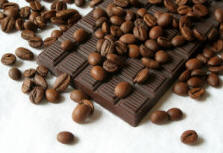History of Chocolate

�
Nataly Nazarenko - Fotolia.co.uk
Go to:
Main History
Index Page
|
History of World Cuisines
|
Origins of
Ingredients
The eating of chocolate has
long been associated with love. Apparently, the Aztec emperor, Monteczuma
(c1502) drank
fifty cups of chocolate a day to enhance his ardour.
Chocolate contains
Phenylethylamine and Serotonin both of which also occur
naturally in the human brain. These mood lifting substances
are released into the nervous system when we are happy and
when we are experiencing feelings of passion creating a a
rise in blood pressure and heart rate and inducing a feeling
of well being. So, when you need a lift -
eat chocolate!
1502 - Christopher Columbus introduces chocolate to Spain from his fourth
voyage to the New World in 1502 but not as the product we know today. It was
only consumed as a drink. The word "chocolate" was derived from the
Aztec word xocolatl which means bitter water.
1615 � Anne of Austria (wife of Louis XIII) declares chocolate as the
drink of the French Court , although this was only after much skepticism, as
initially it was considered a "barbarous product and noxious drug".
1640 � chocolate finds its way to England, among other European
countries.
1657- the drink becomes a
best seller in England and excessive duties are imposed on chocolate. It takes
almost 200 years before the duty is dropped.
1828 - Dutch chocolate maker Conrad J. Van Houten created the hydraulic
cocoa press. The press enabled chocolate makers to crush the "nibs,"
or centers, of roasted cacao beans into a paste (Chocolate Liquor). After
crushing, some of the cocoa butter was extracted.
1848 - English chocolate maker Joseph Storrs Fry created the first eating
chocolate by further refining the cocoa, adding sugar, and mixing the cocoa
butter back in.
1875 -
Swiss Daniel Peter added condensed milk
to chocolate and marketed
the first solid milk chocolate bar.
Back to top
When using chocolate for
culinary purposes, use as high a
quality as you can afford - i.e. containing
higher proportions of cocoa solids,
preferably 40% for milk chocolate and 70% for dark chocolate. This
information can usually be found in the ingredients section on the label.
Be very careful when melting chocolate
as too high a heat can make it split. Therefore always melt in a heatproof bowl
over very hot water in a small saucepan. It can also be successfully melted in
the microwave using a medium setting.
For more information about chocolate
visit our
Chocolate ingredient analysis page.
For lots
chocolate recipes visit the Chocolate
Recipes page or go to the
Search
Page and type in
chocolate.
|